The Ruddy Duck (Oxyura jamaicensis) is a small, chestnut duck with a white cheek and a light blue bill.
This waterfowl species dives for food in shallow marshes, reservoirs, lakes, and coastal waters in central Canada, much of the western USA, the Great Lakes region, Mexico, and the Caribbean.
If you see a small duck with a large head, pale face, and dark, pointed tail feathers, you might have seen a Ruddy Duck. Watch for this common bird on larger marshes and bodies of water in its range.
On this page
Identification
The male Ruddy Duck is a handsome little duck with rich chestnut plumage, bright white face and throat, and a black cap that extends down onto the back of its neck. It also has a big, light blue beak, pale belly, and a fairly long, pointed dark tail.
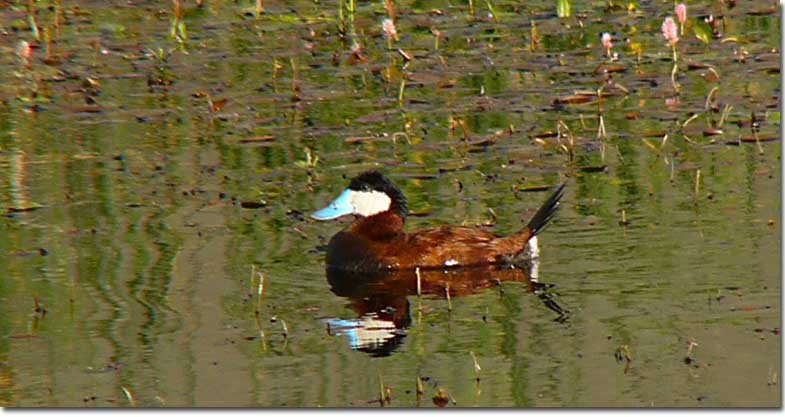
Male Ruddy Duck
During the fall and winter months, male Ruddy Ducks change their chestnut plumage for gray-brown colors. They still have a dark cap and white cheeks but have a grayish beak.
On average, these ducks are around the same size as a Blue-winged Teal (15 inches long), have a wingspan of 18.5 inches, and weigh 1.2 pounds. Female Ruddy Ducks are shaped like males and are close in size, but they are gray-brown with indistinct mottling and barring on their underparts.
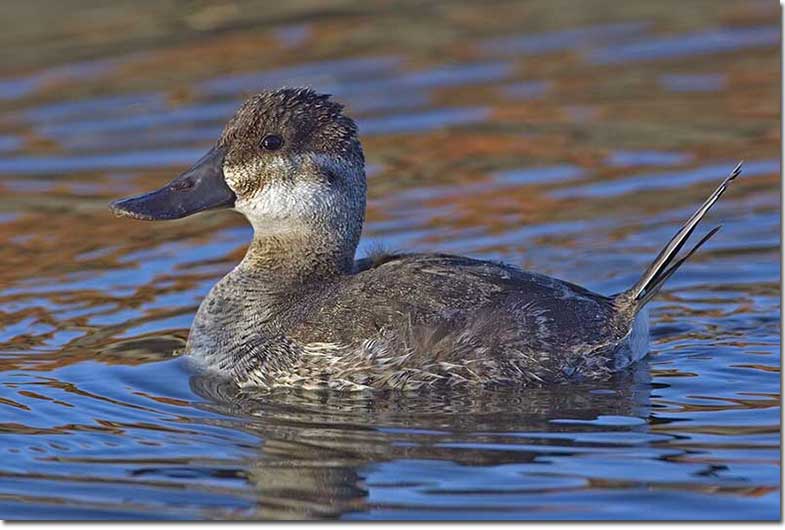
Female Ruddy Duck
They also have a gray beak, dark upperparts, and a dark line on their dingy white face.
In flight, Ruddy Ducks fly quickly with rapid wingbeats. During their direct flight, we can see their pale belly, pointed tail, and can sometimes note the pale markings on their underwings. The upper part of their wings is uniformly dark.
Ruddy Ducks are usually quiet, but males sing an odd staccato or bubbling song during courtship. Females occasionally make nasal and squealing calls.
Food
Ruddy Ducks feed on a variety of aquatic insects, small mollusks, and some plant matter. On their breeding grounds, midge larvae make up a large part of their diet .They also feed on caddisfly larvae, small snails, diving beetles, worms, and other small creatures.
During migration and winter, they also eat small insects when they can find them but include a lot more vegetation in their diet.
However, this might be related to available food sources rather than preference. In any case, they can feed on wild celery, aquatic grass species, seeds, and water lilies among other plants.
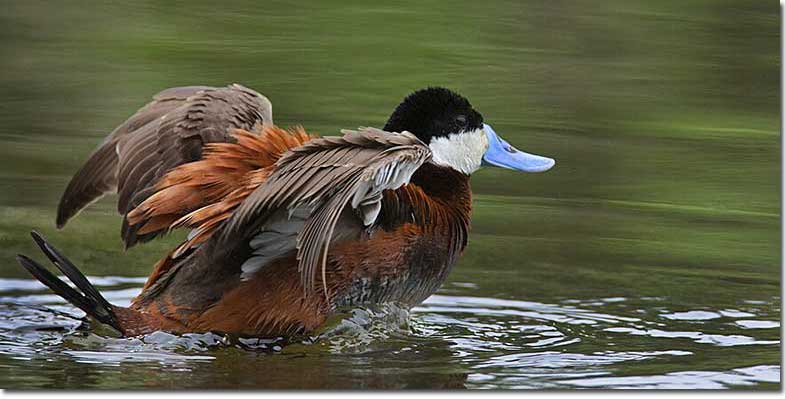
This small duck mostly forages by diving to the bottom of marshes and other bodies of shallow water, and then using its beak to probe in the mud.
It dives with its wings closed, feathers held tight against its body, and usually forages underwater for around 20 seconds.
After it sticks its beak in the mud, the Ruddy Duck opens and closes its bill while moving it back and forth. As it does this maneuver, the duck strains tiny creatures out of the mud. They can also use their beak to skim tiny insects larvae from the surface of the water.
Nesting and Eggs
Ruddy Ducks form pairs not long after arriving back to their breeding grounds in early spring. Around three to five weeks later, the female builds a platform nest hidden in dense marsh vegetation.
She can also use old nests of other duck species but usually constructs her own nest out of dry and dead marsh plants, and other vegetable matter. Her nest also typically has some sort of roof woven over it, and, if water levels rise, she adds more vegetation to the nest to keep it from being submerged.
Female Ruddy Ducks lay seven to nine large, dull white or buff eggs. The eggs are 2.4 inches long and weigh 2.6 ounces.
She incubates them for 23 days and, when approaching her nest, swims underwater and then quietly surfaces near it in a prone position. To avoid predators, she also climbs onto the nest with her head and neck held low on the water.
After the young ducks hatch, they leave the nest the next day and follow their mother around for 20 more days. During the first week, if threatened, the mother duck leads her nestlings to dense marsh vegetation. After the first week, she brings them to open water.
Current Situation
Ruddy Ducks breed in marshes and lakes in central Canada, around the Great Lakes, in the western USA, the Caribbean, and in Mexico.
They winter in shallow waters near Vancouver, and in much of the western and southern USA, and along the east coast north to Massachusetts. These small ducks also winter in Mexico, the Caribbean, and parts of Central America.
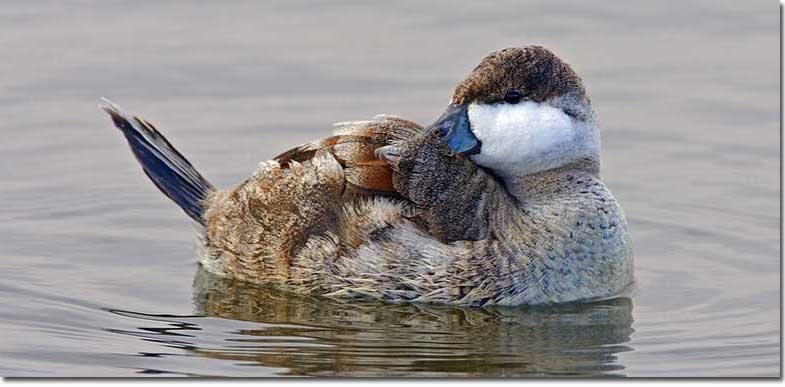
Male ruddy duck in winter plumage
This species is listed as Least Concern in the IUCN Red List and is fairly common throughout its range.
Ruddy Ducks are believed to have a large and stable population. They may be increasing in numbers but are susceptible to degradation of the freshwater marshes they depend on for breeding. If such marshes in central Canada are affected by burning or pollution, the Ruddy Duck could become threatened. They can also be affected by pollution, especially on their wintering grounds.
Facts
- Ruddy Ducks lay larger eggs than any other duck species for their size. They may have such large eggs so their young can be more developed and ready to feed on their own as soon as they hatch.
- During the nesting season, Ruddy Ducks become very aggressive. They chase each other, other duck species, and even some small mammals that get too close to their nest.
- After being introduced to Europe, this bird became a problematic and invasive species that quickly increased and threatened native duck species.
- When birds were hunted for markets in the late 1800s and early 1900s, Ruddy Ducks became a favorite target because they dove instead of flying away and were thus easier to shoot. In common with many other bird species, overhunting during that time is believed to have greatly reduced their numbers. Since then, they have increased once again to become common birds in many places.
Similar Species
Few species resemble the Ruddy Duck but it could be potentially confused with a couple other small ducks.
Masked Duck
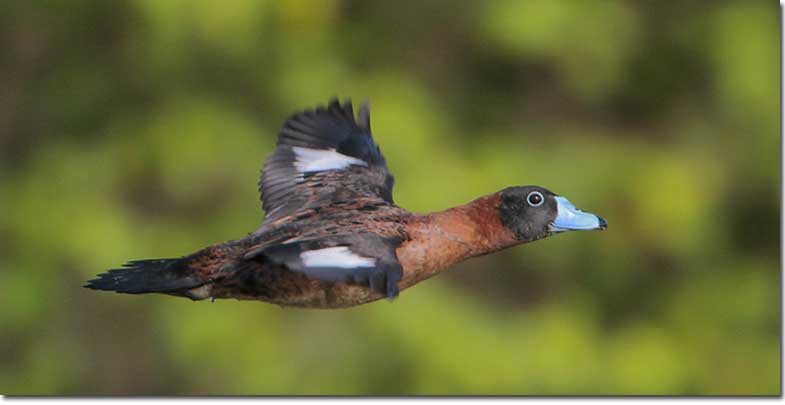
This species is related to the Ruddy Duck and shares several similar field marks. The male also has chestnut plumage, a blue beak, a black crown, and a pointed tail. However, it lacks the white face of the Ruddy Duck, has a streaked back, and shows a white patch on top of its wings in flight.
Female and juvenile Masked Ducks resemble female Ruddy Ducks but have paler, more mottled and barred plumage, and two distinct dark lines on their buff face. Like the adult male, they also show a white patch on their wings when flying.
Bufflehead
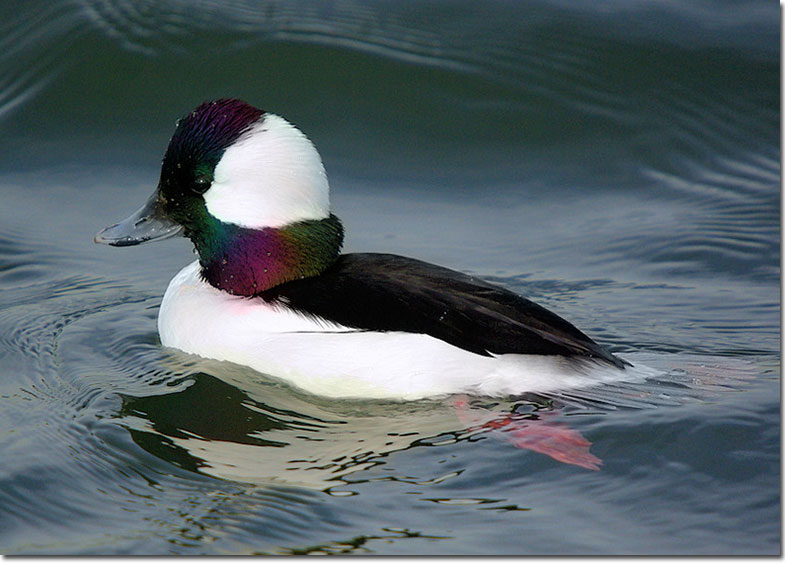
The Bufflehead can occur in some of the same coastal waters as the Ruddy Duck. It also dives and the female shows a bold white mark on the side of her head. However, this white mark is much smaller than the Ruddy Duck’s. The Bufflehead also has a much smaller, stubbier beak.
Frequently Asked Questions
Why is it called a Ruddy Duck?
It is called a Ruddy Duck because of the male’s dark chestnut plumage.
Why do Ruddy Ducks have blue bills?
Ruddy Ducks have blue bills to help them attract a mate. Since they use their beak during courtship, its color probably plays an important role.
Where are Ruddy Ducks found?
Ruddy Ducks are found in shallow marshes, lakes, reservoirs, and coastal waters in central and western Canada, the western USA, the Great Lakes region, Mexico, and the Caribbean. They also winter in the southern USA and along much of the eastern seaboard.
Can Ruddy Ducks walk on land?
No, Ruddy Ducks have a very difficult time walking on land. Since their legs are placed far back on their bodies, they can only push themselves with their feet.
Why are Ruddy Ducks being eradicated?
In Europe, Ruddy Ducks are being eradicated because they are a non-native, invasive species. This duck interbreeds with the related White-headed Duck and threatens it with extinction in Europe.

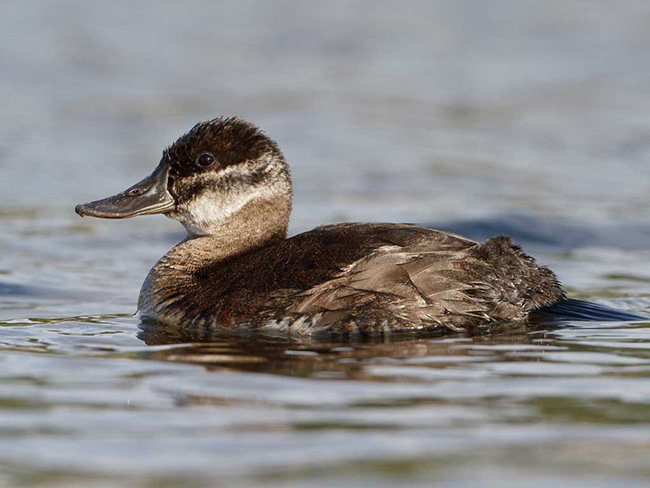

George Heck
Monday 11th of March 2024
Can North American ruddy ducks interbreed with the South African blue billed stiff-tail duck
Patrick O'Donnell
Monday 18th of March 2024
@George- Since a lot of ducks interbreed, especially the ones in the same genus as the Ruddy Duck, I bet they can.